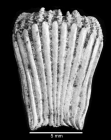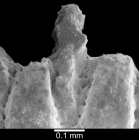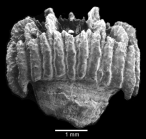WoRMS taxon details
Idiotrochus Wells, 1935
267500 (urn:lsid:marinespecies.org:taxname:267500)
accepted
Genus
Sphenotrochus emarciatus Duncan, 1865 † accepted as Idiotrochus emarciatus (Duncan, 1865) (type by original designation)
Sphenotrochus (Idiotrochus) Wells, 1935 · unaccepted > superseded combination
- Species Idiotrochus alatus Cairns, 2004
- Species Idiotrochus australis (Woods & Duncan, 1865)
- Species Idiotrochus emarciatus (Duncan, 1865)
- Species Idiotrochus kikutii (Yabe & Eguchi, 1941)
- Species Idiotrochus strongylus Kitahara & Cairns, 2021
- Species Idiotrochus perexigua (Dennant, 1906) accepted as Idiotrochus emarciatus (Duncan, 1865) (unaccepted > junior subjective synonym)
marine, fresh, terrestrial
recent + fossil
(of Sphenotrochus (Idiotrochus) Wells, 1935) Wells JW. (1935). Notes on some turbinolid corals. <em>Annals and Magazine of Natural History, Series 10.</em> 16: 529-535, pl. 18. [details]
Status originally described as a subgenus of Sphenotrochus, but elevated to genus level by Vaughan and Wells (1943)
Depth range 82-645 m
Fossil range Early Oligocene to Recent
Status originally described as a subgenus of Sphenotrochus, but elevated to genus level by Vaughan and Wells (1943) [details]
Depth range 82-645 m
Depth range 82-645 m [details]
Fossil range Early Oligocene to Recent
Fossil range Early Oligocene to Recent [details]
Hoeksema, B. W.; Cairns, S. (2024). World List of Scleractinia. Idiotrochus Wells, 1935. Accessed through: World Register of Marine Species at: https://www.marinespecies.org/aphia.php?p=taxdetails&id=267500 on 2024-04-23
Date
action
by
![]() The webpage text is licensed under a Creative Commons Attribution 4.0 License
The webpage text is licensed under a Creative Commons Attribution 4.0 License
original description
(of Sphenotrochus (Idiotrochus) Wells, 1935) Wells JW. (1935). Notes on some turbinolid corals. <em>Annals and Magazine of Natural History, Series 10.</em> 16: 529-535, pl. 18. [details]
context source (Hexacorallia) Fautin, Daphne G. (2013). Hexacorallians of the World. (look up in IMIS) [details]
basis of record van der Land, J. (ed). (2008). UNESCO-IOC Register of Marine Organisms (URMO). , available online at http://www.marinespecies.org/urmo/ [details]
additional source Cairns, S.D., L. Gershwin, F.J. Brook, P. Pugh, E.W. Dawson, O.V.; Ocaña, W. Vervoort, G. Williams, J.E. Watson, D.M. Opresko, P. Schuchert, P.M. Hine, D.P. Gordon, H.I. Campbell, A.J. Wright, J.A.Sánchez & D.G. Fautin. (2009). Phylum Cnidaria: corals, medusae, hydroids, myxozoans. <em>in: Gordon, D.P. (Ed.) (2009). New Zealand inventory of biodiversity: 1. Kingdom Animalia: Radiata, Lophotrochozoa, Deuterostomia.</em> pp. 59-101., available online at https://repository.si.edu/handle/10088/8431 [details] Available for editors [request]
[request]
additional source Cairns, S.D., R. Baron-Szabo, A.F. Budd, B. Lathuilière, E. Roniewicz, J. Stolarski & K.G. Johnson. (2010). Corallosphere. , available online at http://www.corallosphere.org [details]
redescription Cairns, S.D. (1989). A revision of the ahermatypic Scleractinia of the Philippine Islands and adjacent waters, Part 1: Fungiacyathidae, Micrabaciidae, Turbinoliinae, Guyniidae, and Flabellidae. <em>Smithsonian Contributions to Zoology.</em> 486: 1-136. [details] Available for editors [request]
[request]
redescription Cairns, S.D. (1997). A generic revision and phylogenetic analysis of the Turbinoliidae (Cnidaria: Scleractinia). <em>Smithsonian Contributions to Zoology.</em> 591: 1-55. [details] Available for editors [request]
[request]
context source (Hexacorallia) Fautin, Daphne G. (2013). Hexacorallians of the World. (look up in IMIS) [details]
basis of record van der Land, J. (ed). (2008). UNESCO-IOC Register of Marine Organisms (URMO). , available online at http://www.marinespecies.org/urmo/ [details]
additional source Cairns, S.D., L. Gershwin, F.J. Brook, P. Pugh, E.W. Dawson, O.V.; Ocaña, W. Vervoort, G. Williams, J.E. Watson, D.M. Opresko, P. Schuchert, P.M. Hine, D.P. Gordon, H.I. Campbell, A.J. Wright, J.A.Sánchez & D.G. Fautin. (2009). Phylum Cnidaria: corals, medusae, hydroids, myxozoans. <em>in: Gordon, D.P. (Ed.) (2009). New Zealand inventory of biodiversity: 1. Kingdom Animalia: Radiata, Lophotrochozoa, Deuterostomia.</em> pp. 59-101., available online at https://repository.si.edu/handle/10088/8431 [details] Available for editors
additional source Cairns, S.D., R. Baron-Szabo, A.F. Budd, B. Lathuilière, E. Roniewicz, J. Stolarski & K.G. Johnson. (2010). Corallosphere. , available online at http://www.corallosphere.org [details]
redescription Cairns, S.D. (1989). A revision of the ahermatypic Scleractinia of the Philippine Islands and adjacent waters, Part 1: Fungiacyathidae, Micrabaciidae, Turbinoliinae, Guyniidae, and Flabellidae. <em>Smithsonian Contributions to Zoology.</em> 486: 1-136. [details] Available for editors
redescription Cairns, S.D. (1997). A generic revision and phylogenetic analysis of the Turbinoliidae (Cnidaria: Scleractinia). <em>Smithsonian Contributions to Zoology.</em> 591: 1-55. [details] Available for editors
 Present
Present  Inaccurate
Inaccurate  Introduced: alien
Introduced: alien  Containing type locality
Containing type locality
From editor or global species database
Comparison Differs from Sphenotrochus in having a papillose columella, P1-2, and alternating costae. [details]Diagnosis Corallum asexually reproduces by transverse division, the anthocyathus cuneiform in shape, often with downward projecting costal spurs (“fishtails”); GCD up to 6.6 mm; theca imperforate; costae independent, smooth (porcellaneous) and flat, alternating in position with septa; septa hexamerally arranged in 3 cycles; 1 crown of 10 or 12 pali; columella linear-papillose. [details]
Remark This genus and family was monographed by Cairns (1997), which included a phylogenetic analysis based on morphology. Four species, two of them known as fossils (see Cairns, 2004). [details]
Status originally described as a subgenus of Sphenotrochus, but elevated to genus level by Vaughan and Wells (1943) [details]
From other sources
Biology azooxanthellate [details]Depth range 82-645 m [details]
Fossil range Early Oligocene to Recent [details]



